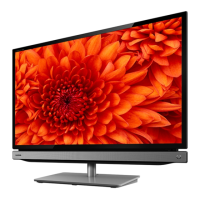
Do you have a question about the Toshiba 32P2300 Series and is the answer not in the manual?
| Screen Size | 32 inches |
|---|---|
| Display Technology | LED |
| HDMI Ports | 2 |
| USB Ports | 1 |
| Refresh Rate | 50 Hz |
| Aspect Ratio | 16:9 |
| Built-in Wi-Fi | No |
| Resolution | 1366 x 768 |
Safety precautions for securely installing the TV to prevent injury.
Warnings for safe operation, environment, and handling of the TV.
Information and procedures for TV repair and maintenance.
Instructions and cautions for cleaning the TV safely.
Notes on LCD screen, interference, and environmental factors.
Guide for connecting an aerial for optimal TV reception.
Steps to install batteries in the TV remote control.
Description of the TV's physical control buttons.
Detailed explanation of each button on the remote control.
Diagram and explanation of the TV's rear input/output terminals.
How to connect external devices using HDMI or DVI interfaces.
Instructions for connecting a PC to the TV for display.
Steps for powering on the TV for the first time.
Guide for initial TV setup, including channel tuning.
How to select the on-screen display language.
How to access and use the TV's quick access menu.
Guide to navigating and using the TV's main menu system.
Changing channel positions, switching, and sorting channels.
How to view current TV information on the screen.
How to choose the input source for viewing external devices.
How to view and select channels from the list.
Setting audio mode for PC or HDMI 1 input.
Adjusting audio settings for HDMI 1 connection.
How to adjust the picture aspect ratio and size.
Using the original picture size without distortion.
How to view standard 4:3 aspect ratio broadcasts.
Stretching 4:3 images to fit the screen with better proportions.
Optimal picture settings for PC input (Normal and Wide).
Adjusting for widescreen DVDs and broadcasts.
Non-scaling display for precise pixel representation.
Full screen display for movies from USB without aspect ratio change.
Full screen display maintaining 21:9 circularity for USB movies.
How to freeze a still image on the TV screen.
Personalizing picture style with preset modes.
Customizing picture settings like brightness and contrast.
Enhancing picture contrast using various levels.
Achieving smoother motion for movies.
Adjusting picture warmth/coolness via RGB levels.
Restoring colour temperature settings to default.
Selecting stereo, mono, or dual sound modes for broadcasts.
Choosing between Dual 1 or Dual 2 audio for bilingual programs.
How to select stereo sound for stereo broadcasts.
How to select bilingual sound for bilingual broadcasts.
How to select mono sound for monaural programs.
Adjusting the balance of sound between left and right speakers.
Selecting preferred sound modes for enhanced audio.
Adjusting bass, treble, and other sound quality parameters.
Enhancing bass response for richer sound.
Restoring advanced sound settings to default.
Controlling Dolby Digital audio compression.
Preventing audio distortion for clearer sound.
Reducing volume differences between channels/inputs.
Visualizing sound frequencies.
Setting the TV to turn on or off automatically.
Automatically adjusting picture format for HDMI signals.
Displaying a blue screen when no signal is detected.
Setting the TV to turn off automatically after inactivity.
Setting the TV to turn off automatically when no signal is present.
Disabling the TV's physical buttons.
Stretching 4:3 programs to full screen.
Displaying software licenses used by the TV.
Checking the TV's software version.
Selecting Teletext language and display mode.
Understanding Teletext basics and page access.
How sub-pages load and are accessed in Teletext.
Displaying subtitles while using Teletext.
Accessing Teletext pages automatically.
Accessing favorite Teletext pages programmed in List mode.
Functions of remote control buttons for Teletext.
Adjusting picture position, clock phase, and sampling clock for PC input.
Restoring PC settings to factory defaults.
How to start and manage the Media Player.
Configuring the Media Player to start automatically with USB insertion.
Manually starting the Media Player.
Modes for viewing photos (Multi View, Single View, Slide Show).
Zooming in and out of photos in viewing modes.
How to exit the photo viewing function.
How to select and play movie files.
Controls for movie playback (pause, fast forward, skip).
Selecting preferred subtitle and audio tracks for movies.
Setting repeat playback options for media files.
Resuming movie playback from the last stopped position.
Registering the TV for DivX Video-On-Demand services.
Removing the TV's DivX VOD registration.
Information about DivX video format and certification.
Information on DivX VOD services and registration.
Playing back DivX Plus HD video files with chapter support.
How to select and play music files.
Setting repeat playback options for music files.
Viewing details about the currently playing media file.
How to exit the music player function.
Supported file types, extensions, and codecs for photo files.
Supported video and audio codecs for AVI files.
Supported video and audio codecs for MPEG formats.
Supported video and audio codecs for MOV and MP4 files.
Supported video and audio codecs for ASF, DivX, and Xvid files.
Supported video and audio codecs for MKV, RM/RMVB, FLV, 3GP, ISO.
Supported audio codecs and formats for music playback.
Solutions for common TV operational problems and symptoms.
Broadcast transmission systems by country or region.
Technical details and specifications of the LED TV.
List of accessories included with the TV.
Legal information regarding trademarks and licenses.